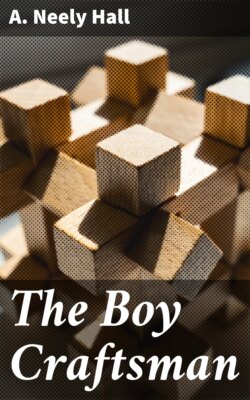Читать книгу The Boy Craftsman - A. Neely Hall - Страница 8
На сайте Литреса книга снята с продажи.
ОглавлениеFig. 34.—Grinding the Chisel.
Figure 34 shows the position to take in grinding
Chisels. Hold the handle of the tool in the right hand and rest the palm of the left hand upon its blade. Then lower the edge upon the stone until the bevel strikes it flatly, and bear down upon the blade with your left hand. Continue the grinding until the bright line of the dull edge has disappeared and an invisible edge has been obtained. Stop when this point is reached or the edge will become feathery and break off, necessitating regrinding. Grind upon the bevelled edge only, and hold the tool in the same relative position, to prevent the bevel from becoming rounded. The angle of the bevel should be about twenty-five degrees. To keep this angle the same, it is desirable to have a rest, consisting of a board nailed to the frame of the stone, upon which to support the handle of the chisel.
Gouges and Draw-knives are ground similarly, the former being rocked from side to side, in order to grind the curved bevel uniformly.
Plane-irons are held with both hands, as shown in Fig. 35, and ground the same, except that the corners of the smoothing-and fore-plane irons are slightly rounded, while the edge of the jack-plane iron is a little higher at the corners than in the centre, to give it the qualities for removing thick shavings. It is more difficult to keep the line between the bevel and upper part of the iron straight than in grinding chisels, on account of the wider blade.
Fig. 35.—Grinding the Plane-iron.
Knives and Hatchets are ground upon both sides of the blade.
Of course, the edge of a tool is left in a very rough condition by the grind-stone, and must be rubbed up on an oil-stone before it is fit to cut with.
There are many makes of whetstones, many good ones and many worthless ones. Above all things, don't buy a cheap one, for it will be impossible to obtain keen edges upon it.
One of the best stones upon the market is
The Washita Oil-stone, a Kansas stone of medium hardness, free from grit and lumps, and of good quality through and through.
Figs. 36–37.
In rubbing up a plane-iron, grasp the end between the thumb and fingers of the right hand and place the palm of the left hand across the iron to bring the necessary pressure upon it (see Fig. 36).
Instead of holding the blade on the stone at the angle of the bevel, tip it to an angle of about thirty-five degrees, or ten degrees more than that of the bevel. With it held in this position, rub it back and forth upon the stone with a rotary motion, making a second narrow bevel along the edge of the tool (see Fig. 37). Be careful to keep the blade in the same position, to prevent the bevels from becoming rounded. By exerting a steady upward pressure against the end of the tool with the right hand, and an equal downward pressure in the centre of the blade with the left hand, this is easily accomplished.
The rough edge which appears on the back of the blade is removed by rubbing the flat side of the iron over the stone a few times. Care must be taken to keep the iron perfectly flat or a bevel will be formed.
A Strop, consisting of a piece of leather fastened to a block of wood as described in the foregoing chapter, should be used after the oil-stone, to put a fine edge upon the tool. The tool is stropped in the same way as a razor is done.
Saws require sharpening but once in a great while if proper care is taken of them. When they do become dull, or need to be set, it is advisable for you to pay an experienced person to do the work rather than attempt it yourself.
